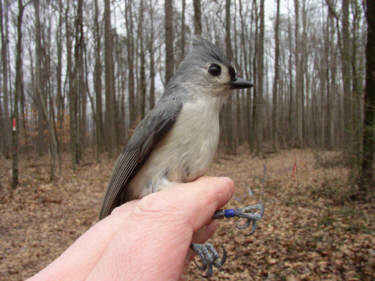Return to Research

Todd M. Freeberg of the University of Tennessee Department of Psychology has established an outdoor aviary at the Forest Resources Center in conjunction with his research. Dr. Freeberg describes his studies: “Students and I are interested in how individuals use vocal signals in their social interactions. We mainly study Carolina chickadees, tufted titmice, and white-breasted nuthatches, using a combination of indoor laboratory, outdoor aviary, and field studies. Our work at the University of Tenness Forest Resources, Research, and Education Center in Oak Ridge has focused on how birds in these groups communicate with one another about the presence of newly-detected food, and about the presence of threatening stimuli such as predators. We also test the relationship between the numbers of individuals in each social flock, and the complexity of the vocal signals those individuals use.”
Some recent publications from work by Dr. Freeberg and his students (in bold) at the Forest Resources Center include:
Freeberg, T.M. (2006). Social complexity can drive vocal complexity: group size influences vocal information in Carolina chickadees. Psychological Science, 17, 557-561.
Owens, J.L., & Freeberg, T.M. (2007). Variation in chick-a-dee calls of tufted titmice, Baeolophus bicolor: note type and individual distinctiveness. Journal of the Acoustical Society of America, 122, 1216-1226.
Freeberg, T.M. (2008). Complexity in the chick-a-dee call of Carolina chickadees (Poecile carolinensis): associations of context and signaler behavior to call structure. Auk, 125, 896-907.
Mahurin, E.J., & Freeberg, T.M. (2009). Chick-a-dee call variation in Carolina chickadees and recruiting flockmates to food. Behavioral Ecology, 20, 111-116.
